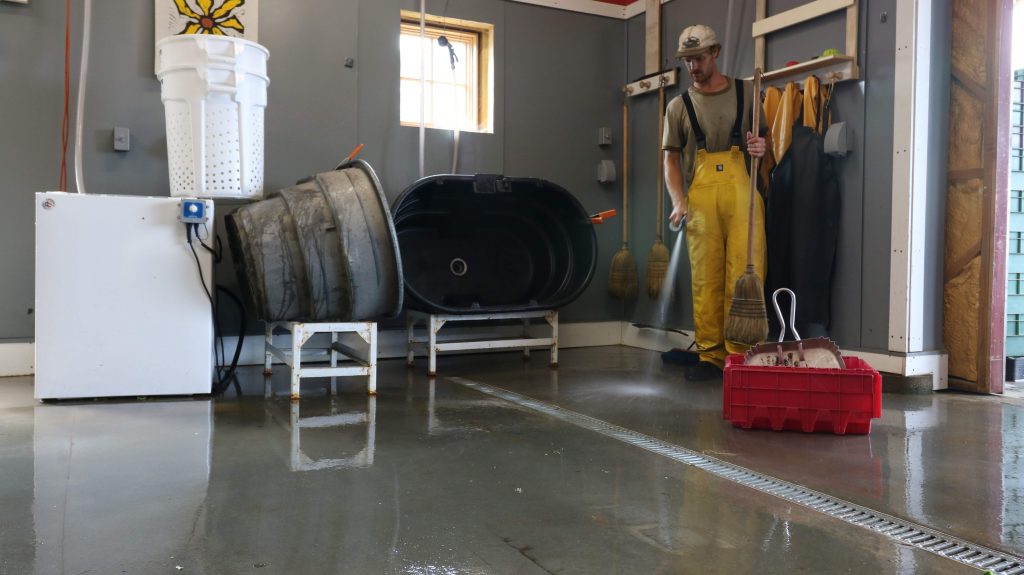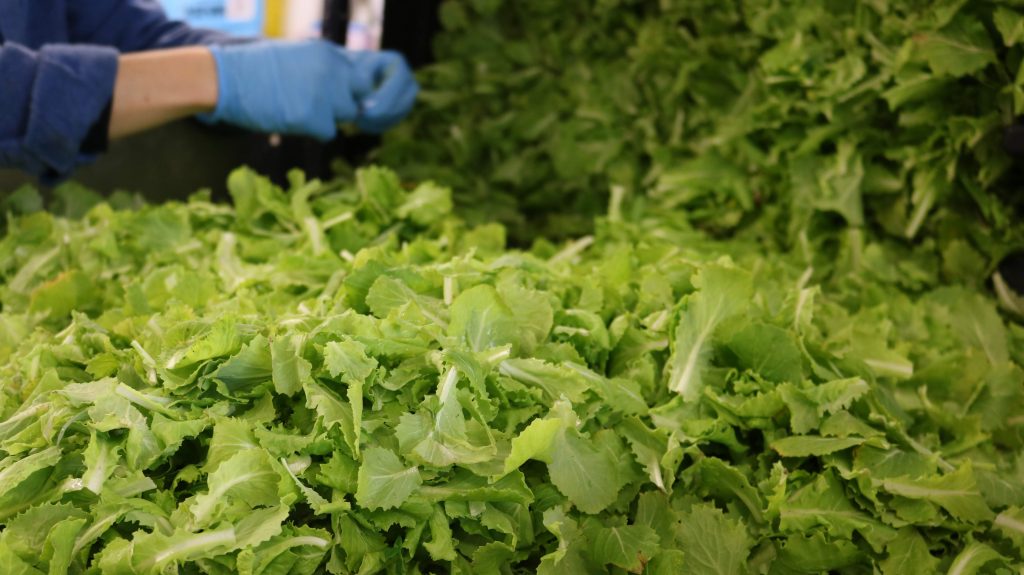Updated 3/18/2020
The current COVID-19 pandemic is a common concern and many are wondering what they can and should do. The information here is intended to help guide the fruit and vegetable farming community. If you have concerns or additional suggestions please contact the UVM Extension Produce Safety Team (producesafety@uvm.edu / (802) 257-7967) or the VT Agency of Agriculture’s Produce Program for additional guidance (agr.fsma@vermont.gov / (802) 828-2433).
Listen on the The Ag Engineering Podcast.
Please also see the compiled resources at the UVM Extension VT Vegetable and Berry Growers Page.
Background

COVID-19 is the disease caused by the SARS-CoV-2 virus (“the novel coronavirus”). Symptoms include fever, cough, and shortness of breath, and may appear 2-14 days after exposure. While the majority of COVID-19 illnesses are mild, it can result in severe and fatal illness, particularly in the elderly and among those with severe underlying health conditions. Federal and State agencies are working hard to better understand the virus, how to control its spread, and how to treat those infected. One of the key things we can all do is to limit and slow the spread of COVID-19 to provide time for this understanding to develop and to not overwhelm the medical system. Much more information is available at the CDC Situational Summary page.
What Should Growers Do?
- Stay Away from Produce if Sick – If someone is sick, they should be nowhere near fruit and vegetables that others are going to eat. This is likely already part of your farm’s food safety plan and policies, but this is a good reminder to emphasize and enforce the policy. Make sure employees stay home if they feel sick and send them home if they develop symptoms at work. Consider posting signs asking customers not to shop at your farm stand if they have symptoms.
- Practice Social Distancing – By putting a bit more space between you and others you can reduce your chances of getting ill. This might mean limiting or prohibiting farm visitors or reducing the number of off-farm meetings you attend in person. Avoid shaking hands and other physical contact. This also reduces the risk of your produce coming into contact with someone who is ill before it heads to market.
- Minimize the Number of Touches – Consider changes in your policies and operations that minimize the number of times produce is touched by different people. This may include workers, distributors, and customers. More examples are provided below in the Q&A section.
- Wash Your Hands – Reinforce the importance of washing hands well when arriving at work, when changing tasks (e.g. moving from office work to wash/pack), before and after eating, after using the bathroom, before putting on gloves when working with produce, and after contact with animals. Soap + water + 20 seconds or more are needed to scrub all surfaces of your hands and fingers thoroughly. Then, dispose of paper towels in a covered, lined trash container.
- Wear a Face Mask (NEW)– The FDA and CDC are now recommending the use of simple cloth face masks as a voluntary public health measure in public settings where other social distancing measures are difficult to maintain. These are not meant to be N95 masks, and they are not meant to protect the wearer. They are meant to limit the transmission of COVID-19 from the wearer who may be asymptomatic. Consider making one of several homemade cloth masks and distributing to employees who may need them. More info available from Penn State.
- Cleaning, Sanitizing, and Drying – According to the FDA , there is no indication that this virus has spread via food. But, we know viruses (including SARS-CoV-2 ) survive and spread via hard surfaces. Farms handle produce using tools and equipment with surfaces. We also know that produce has surfaces. Viruses, in general, can be relatively long-lasting in the environment, and have the potential to be transferred via food or food contact surfaces. So, there’s no better time than the present to review, improve, and reinforce your standard operating procedures for cleaning, sanitizing, disinfecting, and drying any food contact surfaces, food handling equipment, bins, and tools. More info is provided below in the Q&A section. Remember, cleaning means using soap and water, sanitizing is using a product labeled for sanitizing, disinfecting typically involves higher concentrations of a product labeled for disinfection, and drying means allowing the surfaces to dry completely before use. For more information visit our expanded post on the topic.
- Plan for Change – Many produce farms are lean operations run by one or two managers and a minimal crew. Do you have a plan for if you become severely ill? How do things change if half your workforce is out sick? More business and labor planning guidance is available at the Cornell Agricultural Workforce Development site .
What Should Markets and Farmers Markets Do?

- Everything Above – Growers, retail food market owners, and farmers market managers should do all the things above. Does your market have a hand washing station? More guidance for food and lodging businesses is available from the Vermont Department of Health .
- Communicate with your Customers – Consider reaching out to your customers and recommend they stay home if they are ill. Have you informed your customers about any changes in your hours or policies?
- Consider Alternative Delivery – Some markets are taking this opportunity to launch pre-ordering and electronic payment options to enable social distancing at market. Some markets are moving to a drive-through pickup option. More examples are provided below in the Q&A section.
- Reinforce the Health Benefits of Fruits and Vegetables – We’re fortunate to have so many growers who do a great job with storage crops and winter production. This means our community has access to fresh fruits and vegetables that are important to their immune systems at this time of need. Be sure to promote the nutritional value of your products! But, keep in mind that promotion of your products should be within reason. Avoid making overly broad or unsupported health claims. Fresh produce contains many minerals and nutrients important for immune health which may reduce the severity and duration of an illness. Fun Fact: Pound for pound, that storage cabbage in your cooler has as nearly as much vitamin C as oranges.
Questions and Answers
- What is the difference between cleaning, sanitizing, and disinfection? See expanded post on this topic.
- What Should I Use for Disinfection and Sanitizing? See expanded post on this topic.
- Should I be disinfecting my produce? As noted above, there is no indication that COVID-19 has spread via produce. The virus is thought to be spread mainly from person to person according to the CDC. For most farms the level of operational change and amount of disinfectant needed to disinfect produce is unrealistic.
- What about using gloves? Gloves can provide a barrier between hands and produce preventing transmission of pathogens from hands to produce and from produce to hands. They aren’t a perfect solution, and require attention to detail when using as a Penn State Extension summary highlights.
- What are farmers’ markets and CSAs doing? Some farmers markets have changed the way they do business to implement some of the best practices listed above.
- Carrborro, NC Farmer’s Market Case Study – NC State Extension has posted a summary of what the Carrboro Farmers’ Market has done.This has included communication with market customers, social distancing by rearranging the market layout, rounding prices for limited use of coins, running a “tab” for customers to minimize cash transactions, no samples, no tablecloths to ease sanitation, and the addition of a hand washing station among other things.
- Minimize the Number of Touches (CSA) – One CSA has decided to change how they distribute to an urban market. The have previously trucked larger bins of produce to a distribution site where customers would select their own produce to fill their share. They have decided to pack the shares to order at the farm prior to distribution to minimize the number of people touching the produce. Another alternative would be packing shares to order at the market. What are other CSAs doing? Send me an email at chris.callahan@uvm.edu, I’ll compile the results.
- Minimize the Number of Touches (Farmers’ Market) – The Bennington Farmers’ Market has shifted to online ordering and pre-bagged orders from each farm that are combined into larger collective orders delivered to each customer via a drive-up system. The biggest decision was deciding that they’d actually continue to have the market. The new approach required the addition of an on-line ordering system (Google Forms for now), coordination among farms and some serious organization at the market. Orders are organized alphabetically, pickups are scheduled with a quarter of the alphabet every 30 minutes. People won’t get out of their cars. What are other markets doing? Send me an email at chris.callahan@uvm.edu, I’ll compile the results.
- What are other farms doing? See the growing list of resources on the VT Vegetable and Berry Site.